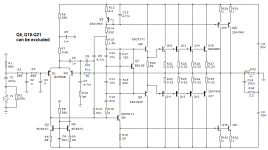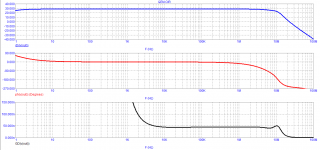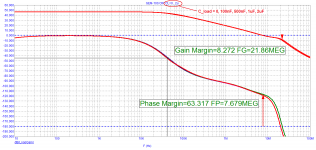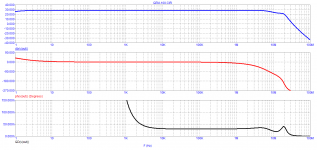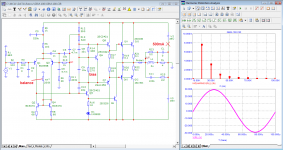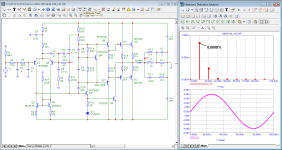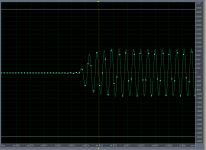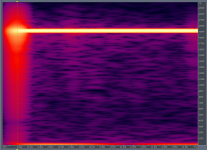OMG
This is probably the most meaningless thread I have ever seen since...
Stein
__________________
Ignorance is bliss
Is this coming from a blissful true prophet that ignorance is bliss?
The "CFA" thread was incredibly controversial and personally challenging, and that from my perspective was most succinctly understood and conveyed by CPaul.
This is probably the most meaningless thread I have ever seen since the: Current Feedback Amplifiers, not only a semantic problem?
Thread
Stein
Being the creator of thread "Current Feedback Amplifiers, not only a semantic problem?", I may say that I am very far from having said my last word about about CFAs.The "CFA" thread was incredibly controversial and personally challenging, and that from my perspective was most succinctly understood and conveyed by CPaul.
Initializing that post is something to be proud of... particularly given its length. Congrats.
Length isn’t everything.
I'm told girth is where it is at, but what do I know? 😀
In memory of Graham
Graham really liked the sound of amplifiers with very low signal transit time (time Propagation Delay), in particular the sound of the JLH-69 class A amplifier.
Graham named his GEM amplifier after his father and used the LJH-69 amplifier circuit as a prototype.
Design goal: to make a more powerful and more economical amplifier while maintaining the properties of the JLH-69 amplifier
Here is one of the simplified versions of such an amplifier.
Graham really liked the sound of amplifiers with very low signal transit time (time Propagation Delay), in particular the sound of the JLH-69 class A amplifier.
Graham named his GEM amplifier after his father and used the LJH-69 amplifier circuit as a prototype.
Design goal: to make a more powerful and more economical amplifier while maintaining the properties of the JLH-69 amplifier
Here is one of the simplified versions of such an amplifier.
Attachments
I see this now has it's own thread. Good idea, we can put this one to rest then.
https://www.diyaudio.com/forums/solid-state/101322-gem-amplifier-2.html#post6480232
Jan
https://www.diyaudio.com/forums/solid-state/101322-gem-amplifier-2.html#post6480232
Jan
a little history
First cycle distortion - Graham, what is that?
millwood
«i hold a lot of respect for Graham, as well as any member on this forum and I think if proven true, FCD
can be a revolutionary step forward in our understanding of audio and human hearing.»
The many faces of distortion
Graham Maynard
«To me 'linearity' has always been 'continuous proportionality'.
That is a fundamental definition that was not written by me, and it is not wrong.
Amplifier amplitude linearity can be measured in time isolation to specify a good thd figure, and
yet reproduction can still sound poor with dynamic waveforms because of the reactive delays associated
with its internal stabilisation and NFB circuitry.
For those who don't deny its existence, this is where First Cycle Distortion observation will show on the
simulator which amplifiers are capable of clean dynamic reproduction; like the JLH class-A is within its
working capabilities.
If all of this really has been widely known for many years, then I wonder why the argument
(and the inappropriate name calling/mischeivous postings by some !) ?»
I tried to answer the question: “First cycle distortion - Graham, what is that? "By its numerous examples in this and other branches (threads):
Musings on amp design... a thread split.
and even wrote a small memo
since I speak English poorly, and use the Google translator, I also saved the Russian text
First cycle distortion - Graham, what is that?
millwood
«i hold a lot of respect for Graham, as well as any member on this forum and I think if proven true, FCD
can be a revolutionary step forward in our understanding of audio and human hearing.»
The many faces of distortion
Graham Maynard
«To me 'linearity' has always been 'continuous proportionality'.
That is a fundamental definition that was not written by me, and it is not wrong.
Amplifier amplitude linearity can be measured in time isolation to specify a good thd figure, and
yet reproduction can still sound poor with dynamic waveforms because of the reactive delays associated
with its internal stabilisation and NFB circuitry.
For those who don't deny its existence, this is where First Cycle Distortion observation will show on the
simulator which amplifiers are capable of clean dynamic reproduction; like the JLH class-A is within its
working capabilities.
If all of this really has been widely known for many years, then I wonder why the argument
(and the inappropriate name calling/mischeivous postings by some !) ?»
I tried to answer the question: “First cycle distortion - Graham, what is that? "By its numerous examples in this and other branches (threads):
Musings on amp design... a thread split.
and even wrote a small memo
since I speak English poorly, and use the Google translator, I also saved the Russian text
Attachments
What do you consider to be a good number for propagation delay through an amplifier, and what do you consider a good method for measuring that?
Graham Maynard
«To me 'linearity' has always been 'continuous proportionality'.
That is a fundamental definition that was not written by me, and it is not wrong.
Well there you have it. The minuscule time after a non-continuous event, i.e. the start of a signal from 0, is not proportional. For how long? 0,0002 ms? Less? One (1) event!
So what? Everything else i.e. the rest except of the non proportional 0,000000000000000000000000000000000000001 % of the "song" is just exposed to a constant group delay corresponding to the propagation delay of the amplifier - you like storing a song on a tape, LP or a CD but just a "little" shorter duration.
Let this go. It's a mirage that is not worth to chase.
//
Last edited:
- Home
- Amplifiers
- Solid State
- First cycle distortion - Graham, what is that?
